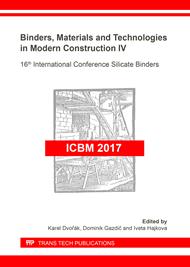p.122
p.128
p.134
p.140
p.148
p.154
p.160
p.167
p.173
Effect of Ammonium Ion Content in Fly Ash after Selective Non-Catalytic Reduction (SNCR) on Physical and Mechanical Properties of Autoclaved Aerated Concrete (AAC)
Abstract:
After introducing SNCR in coal combustion process in power plants, the valuable by-product such as fly ash remains contaminated with amount of ammonia in form of NH4HSO4, (NH4)2SO4 respectively, which became undesirable in AAC technology because the toxic ammonia is released in the air during the mixing process. This paper deals with the effect of varying ammonia content in fly ash after selective non-catalytic reduction (SNCR) on the physical-mechanical properties of the fly ash based autoclaved aerated concrete (AAC) with the main focus on determination of the impact of the various content of ammonium ion in fly ash on the initial consistency of fresh slurry, the residual content of ammonium ion in hardened aerated matrix and also the impact on the bulk density, compressive strength and tobermorite formation after hydrothermal treatment. Seven batches of AAC, made out of fly ash with rising content of ammonium ion from 0 ppm to 250 ppm, were tested and based on the results obtained it was found out that ammonia is released during the mixing process entirely and doesn‘t remain in AAC after autoclaving, moreover it doesn‘t affect the properties of both fresh slurry (no apparent foaming effect noticed) and thermally treated samples of AAC. Formation of tobermorite wasn’t negatively affected.
Info:
Periodical:
Pages:
148-153
Citation:
Online since:
June 2018
Authors:
Price:
Сopyright:
© 2018 Trans Tech Publications Ltd. All Rights Reserved
Share:
Citation:


